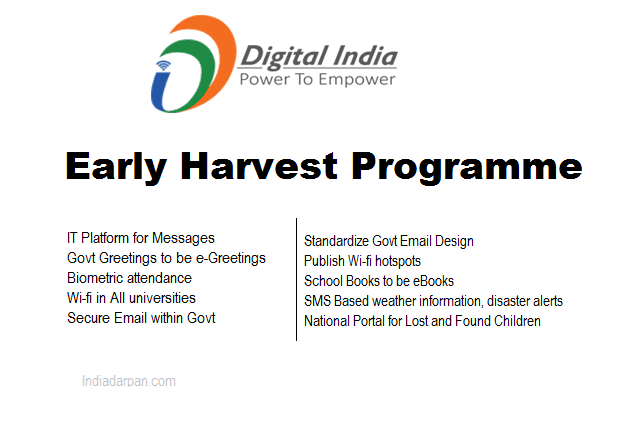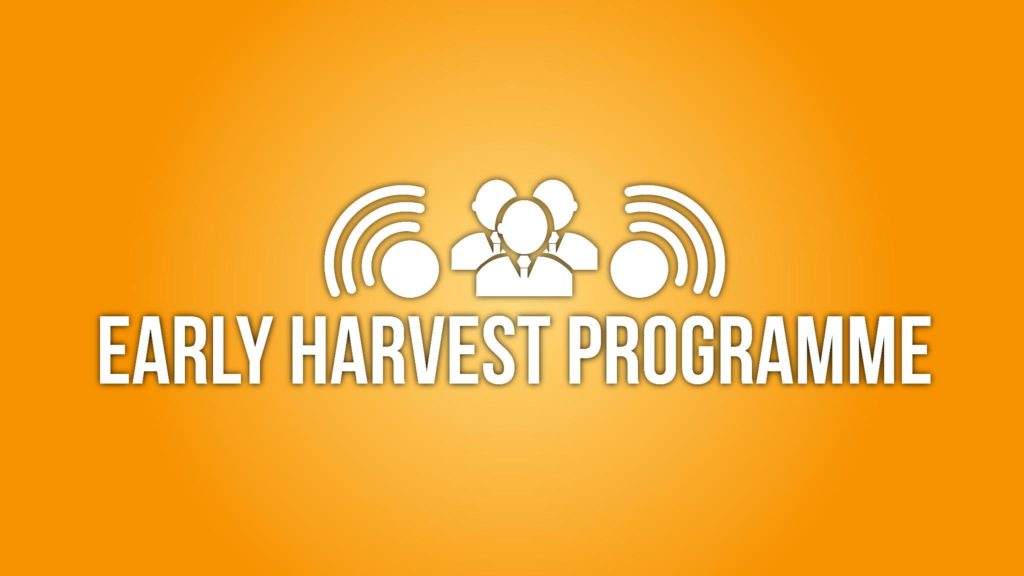- Wiki
- Updated on March 6, 2025
Early Harvest Programme | Digital India : Complete Information

The Government of India is making significant efforts to raise awareness about the benefits of digitization. One of the core initiatives of the Modi government is the launch of the Digital India campaign, which aims to bring about revolutionary changes in various sectors. A key component of this initiative is the Early Harvest Programme, designed to implement digital solutions into traditional government processes. This program focuses on transforming existing government practices to enhance service delivery and reach the public more effectively.
Projects Under the Early Harvest Programme
The Early Harvest Programme comprises a range of projects, each designed to introduce digital solutions to government services. These projects aim to streamline processes, improve efficiency, and make services more accessible to citizens. Below is an overview of the key projects under this program and their objectives.

Biometric Attendance System
A major change under the Early Harvest Programme is the Biometric Attendance System. This system requires central government employees to register their attendance through biometric verification linked to their Aadhaar number. A web-based application tracks the arrival and departure times of employees, ensuring accurate attendance records. The Department of Electronics and IT has already rolled out this system in several government offices, marking a step toward greater transparency and efficiency.
IT Platform for Public Messaging (Sampark)
The Sampark platform is designed to facilitate communication between the government and the public. It stores contact details of central and state government employees, allowing the government to send messages quickly and efficiently. Notably, Prime Minister Modi used this platform to send Independence Day greetings to millions of people. This system helps improve communication between the government and citizens, ensuring timely dissemination of important information.
E-Greetings for Government
The Ministry of Communications launched the E-Greetings platform to replace traditional greeting cards with digital versions. Launched on 14th August 2014, this platform allows the government to send greetings on special occasions like Independence Day and Republic Day. The first greeting was sent by the Prime Minister on 15th August 2014 to over 32 lakh users. Since then, this platform has been used on many occasions to send greetings digitally, promoting environmental sustainability and reducing paper waste.
Secure Email System for Government Use
To ensure the security of communication within the government, the Digital India initiative introduced a secure email system. This system helps safeguard sensitive government communications and protects them from cyber threats. By establishing a secure digital communication framework, the government aims to prevent cybercrimes and data breaches within government departments, enhancing the safety and privacy of official correspondence.
Standardized Government Email Templates
The government is working to create standardized email templates for official communications. This initiative aims to make messages more consistent and effective while maintaining a uniform tone and style. The standardized templates will help ensure that the intended message reaches citizens in a clear and professional manner.
National Portal for Missing and Found Children
Under the Early Harvest Programme, the government has upgraded the National Portal for Missing and Found Children. This portal is now accessible to a wide range of stakeholders, including the Ministry of Women and Child Development (MWCD), Ministry of Home Affairs (MHA), the police, child welfare institutions, and other related bodies. The platform allows users to register complaints about missing children and receive updates via email or SMS. This initiative aims to improve the process of locating missing children and ensure quicker responses.
Public Wi-Fi Hotspots for Free Internet Access
A major initiative under the Early Harvest Programme is the establishment of Public Wi-Fi Hotspots. The government has launched free internet services at various public places such as railway stations, airports, educational institutions, metro stations, and markets. The aim is to provide free and high-speed internet to the public, ensuring that more people have access to digital resources. By offering internet access in public spaces, the government hopes to bridge the digital divide and promote digital literacy.
Converting School Books to eBooks
The Ministry of Human Resource Development (HRD), in collaboration with DeitY, is working to convert traditional school books into eBooks. This initiative aims to lighten the burden of carrying heavy textbooks for students. With access to eBooks, students can easily carry multiple books on digital devices like tablets or smartphones, making learning more convenient. This initiative is part of the government’s broader goal to make education more accessible through digital means.
SMS-Based Weather and Disaster Alerts
As part of the Early Harvest Programme, the government is sending SMS-based weather and disaster alerts to people in the Sampark database. These alerts will inform citizens about critical weather updates or any impending disasters, enabling them to take necessary precautions. The service is designed to keep the public informed in real-time, especially in areas prone to natural disasters, ensuring timely response and preparedness.
Benefits and Reception of the Early Harvest Programme
The Early Harvest Programme has received positive feedback from various experts and stakeholders. It has been hailed as a step in the right direction, aiming to modernize government services and make them more accessible to the general public. The program leverages the power of digital technologies to improve efficiency, transparency, and security within government operations. By implementing digital solutions, the government hopes to create a more connected and informed society.
These projects are just the beginning, and there is still a long way to go before the full benefits of the Early Harvest Programme are realized. However, the response has been overwhelmingly positive, with many viewing it as an important part of India’s digital transformation.
Conclusion
The Early Harvest Programme is an essential component of the Digital India initiative, aiming to integrate digital solutions into traditional government platforms. With projects like biometric attendance, public Wi-Fi hotspots, secure emails, and eGreetings, the government is taking significant steps to enhance communication, efficiency, and public service delivery. While these initiatives are still in the implementation phase, they have the potential to revolutionize the way the Indian government operates and interacts with citizens. As these programs continue to evolve, they will help bridge the digital divide and bring about a more inclusive, connected, and digitally empowered India.
If you have any questions or thoughts about the Early Harvest Programme, feel free to share them in the comments below. Your insights may help others understand this transformative initiative better.
Join the discussion
Related Articles
No results available
ResetTrending Articles


- Health
- Updated on January 9, 2026


- General
- Updated on January 7, 2026


- Health
- Updated on January 3, 2026

- General
- Updated on January 5, 2026


- General
- Updated on January 1, 2026


- General
- Updated on December 27, 2025


- General
- Updated on December 22, 2025


- General
- Updated on December 20, 2025


- General
- Updated on December 16, 2025


- General
- Updated on December 15, 2025
No results available
Reset


